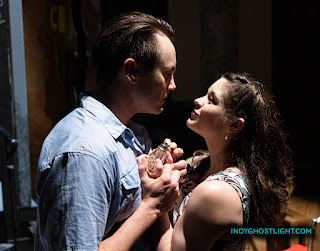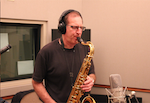ISO Classical Series begins: A good ride through the Brahms First, Shostakovich adding flame decals
Krzysztof Urbanski shored up his success in major works of Johannes Brahms Friday night as he led a revelatory reading of the Symphony No. 1 in C minor to open the Classical Series of the Indianapolis Symphony Orchestra.
He has programmed the two piano concertos (Dejan Lazic the soloist in both, and Andre Watts on hand for 2014 performances of the second), the double concerto with two ISO principals last November, and the German Requiem in April 2017.
Of the four symphonies, the ISO music director got good results with the Fourth in 2014. His way with the Second and Third symphonies will be eagerly awaited this season; the Fourth will make a return visit as well. Certainly there was nothing to quibble about under the magic touch Urbanski brought to Brahms' long-delayed debut as a symphonist.
Material that made its way into the 1876 C minor symphony can be dated back a decade and a half before the premiere. The intention to write his first symphony goes back to the composer's early 20s. So it may not be too much of a stretch to say that what Urbanski accomplished with his orchestra Friday night at Hilbert Circle Theatre was to find the youthful Brahms in the finished masterpiece of his maturity.
The earnestness of the first movement, established with the opening gestures and steady timpani pattern, did not become too heavy. The music unfolded in animated fashion, with good forward motion that was varied at cadences and significant changes of direction. The second movement floated charmingly, with fine solo work from oboist Roger Roe and guest concertmaster Susie Park.
In this performance, the way solo lines interweave to launch the third movement moved to the fore the charming side of Brahms — the "ungruff" aspect sometimes undervalued, but well-known from the Liebeslieder Waltzes, the late piano pieces and elsewhere. The young Brahms, something of a dreamboat as a young man, in contrast to the stout, bearded Viennese celebrity of his premature old age, definitely came through as the finale got under way.
In the long introduction, the famous horn call sounded boldly, as if heard over mountain passes: The composer himself once quoted it in a birthday card to Clara Schumann, comparing it to an Alpine horn. The evocation of wide vistas adheres naturally to it. I remember from long ago a scene in the old TV show "Bonanza," with Hoss Cartwright gazing out over the mesa; the underscoring quoted that passage.
Urbanski intensified the tempo as the movement developed its main theme, which was immediately compared (to the composer's annoyance) to Beethoven's "Ode to Joy" melody. This lent an attractive air of triumphalism to the tune, which transitions from hymn to anthem. The return of the horn call near the end becomes ecstatic, and in this performance was perfectly judged for maximum effect.
I should think a further advance on Urbanski's presentation of repertoire staples would have made this weekend's concerts an obvious candidate for marketing focused on the Brahms symphony. Instead, the concerts have been labeled "Jazzy Shostakovich." A promo on WFYI-FM touted the ISO's program only as "a couple of Shostakovich works," with no mention of the Brahms. I'm further puzzled by my failure to find any suggestion of jazz in either "Festive Overture" or the Piano Concerto No. 1 for Trumpet and Strings, op. 35. Perhaps we have reached a point culturally where Shostakovich is a bigger draw than Brahms, but you wouldn't know that from the huge ovation the First Symphony received Friday night.
Nevertheless, the sprightly concerto also made a strong impression. Dejan Lazic, who seems to be Urbanski's favorite pianist, was in his element projecting the score's wit and verve. He made the contrasting second movement sound better than it is, and that's a good thing. A certain degree of yearning sentimentality fools the ear into believing Shostakovich is being profound here.
The only flaw was a slightly smudged trumpet entrance at a point where the brassy partner's return is eagerly anticipated. Otherwise, Conrad Jones' performance of the glittering solos complementing the piano was first-rate — his low register was especially beguiling. And who could resist his contributions to the circusy finale, with its frenetic fanfare figures helping piano and orchestra bring everything to a riotous conclusion?
As close to cliche as the fourth movement is, its quality — along with all that precedes it — is far superior to the potboiler Festive Overture. True, the aptly named piece fulfilled the function of a seasonal curtain-raiser. Its noisy energy is nearly relentless, except for some delicate episodes that Urbanski and the orchestra lent full support to. It deserves the chance to be trotted out on occasion — rarely and in the right place, as it was here.
 |
| The ISO's music director adds to distinguished Brahms performances. |
Of the four symphonies, the ISO music director got good results with the Fourth in 2014. His way with the Second and Third symphonies will be eagerly awaited this season; the Fourth will make a return visit as well. Certainly there was nothing to quibble about under the magic touch Urbanski brought to Brahms' long-delayed debut as a symphonist.
Material that made its way into the 1876 C minor symphony can be dated back a decade and a half before the premiere. The intention to write his first symphony goes back to the composer's early 20s. So it may not be too much of a stretch to say that what Urbanski accomplished with his orchestra Friday night at Hilbert Circle Theatre was to find the youthful Brahms in the finished masterpiece of his maturity.
The earnestness of the first movement, established with the opening gestures and steady timpani pattern, did not become too heavy. The music unfolded in animated fashion, with good forward motion that was varied at cadences and significant changes of direction. The second movement floated charmingly, with fine solo work from oboist Roger Roe and guest concertmaster Susie Park.
In this performance, the way solo lines interweave to launch the third movement moved to the fore the charming side of Brahms — the "ungruff" aspect sometimes undervalued, but well-known from the Liebeslieder Waltzes, the late piano pieces and elsewhere. The young Brahms, something of a dreamboat as a young man, in contrast to the stout, bearded Viennese celebrity of his premature old age, definitely came through as the finale got under way.
In the long introduction, the famous horn call sounded boldly, as if heard over mountain passes: The composer himself once quoted it in a birthday card to Clara Schumann, comparing it to an Alpine horn. The evocation of wide vistas adheres naturally to it. I remember from long ago a scene in the old TV show "Bonanza," with Hoss Cartwright gazing out over the mesa; the underscoring quoted that passage.
Urbanski intensified the tempo as the movement developed its main theme, which was immediately compared (to the composer's annoyance) to Beethoven's "Ode to Joy" melody. This lent an attractive air of triumphalism to the tune, which transitions from hymn to anthem. The return of the horn call near the end becomes ecstatic, and in this performance was perfectly judged for maximum effect.
 |
| Dejan Lazic: Pianist brings pizazz and wistfulness to Shostakovich. |
Nevertheless, the sprightly concerto also made a strong impression. Dejan Lazic, who seems to be Urbanski's favorite pianist, was in his element projecting the score's wit and verve. He made the contrasting second movement sound better than it is, and that's a good thing. A certain degree of yearning sentimentality fools the ear into believing Shostakovich is being profound here.
 |
| ISO principal Conrad Jones: Nearly flawless |
The only flaw was a slightly smudged trumpet entrance at a point where the brassy partner's return is eagerly anticipated. Otherwise, Conrad Jones' performance of the glittering solos complementing the piano was first-rate — his low register was especially beguiling. And who could resist his contributions to the circusy finale, with its frenetic fanfare figures helping piano and orchestra bring everything to a riotous conclusion?
As close to cliche as the fourth movement is, its quality — along with all that precedes it — is far superior to the potboiler Festive Overture. True, the aptly named piece fulfilled the function of a seasonal curtain-raiser. Its noisy energy is nearly relentless, except for some delicate episodes that Urbanski and the orchestra lent full support to. It deserves the chance to be trotted out on occasion — rarely and in the right place, as it was here.



Comments
Post a Comment